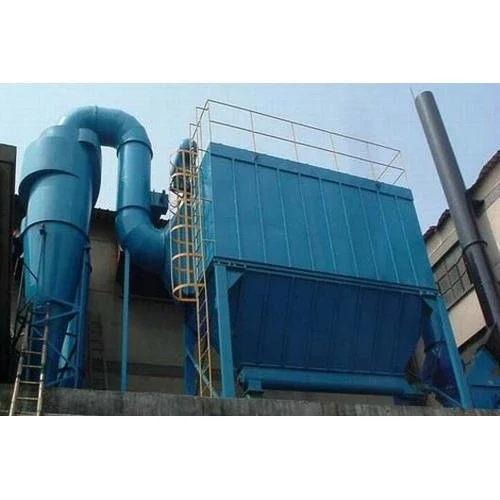Cyclone Dust Collector
Home / Products / Dust Collector Manufacturers/ Cyclone Dust Collector
Cyclone Dust Collector Manufacturers
A cyclone dust collector is a type of industrial air filtration system designed to capture and remove airborne dust particles and debris from various processes, such as woodworking, metalworking, and other industrial applications. Here’s an in-depth look at cyclone dust collectors, including their features, working principle, applications, benefits, and considerations:
Working Principle of Cyclone Dust Collector
- Inlet: Dust-laden air enters the cyclone dust collector through one or more inlet ports, typically located at the top of the cyclone chamber.
- Cyclonic Separation: As the air enters the cyclone chamber, it is forced into a swirling motion by the internal baffles or vanes. Centrifugal force causes heavier dust particles to be thrown against the walls of the chamber, where they lose momentum and fall into the collection bin below.
- Filtration: The cleaner air, along with finer dust particles that escape cyclonic separation, passes through the filters downstream of the cyclone chamber. These filters capture remaining dust particles before the air is discharged back into the environment.
- Collection: Dust and debris collected in the cyclone chamber are deposited into the collection bin or drum, where they can be easily emptied and disposed of.

Cyclone Dust Collector Manufacturers
Features of Cyclone Dust Collector
- Cyclonic Separation: Cyclone dust collectors operate on the principle of cyclonic separation, where incoming dust-laden air is forced into a swirling motion inside a cylindrical or conical chamber. This centrifugal force causes the heavier particles to be flung against the walls of the chamber and fall into a collection bin below, while the cleaner air exits through an outlet.
- Multiple Inlets: Cyclone dust collectors often feature multiple inlet ports, allowing them to connect to multiple machines or workstations simultaneously for efficient dust collection.
- High-Efficiency Filtration: Many cyclone dust collectors utilize pleated cartridge filters or bags downstream of the cyclone chamber to capture fine dust particles that escape cyclonic separation, ensuring cleaner air emissions.
- Durable Construction: They are typically constructed of heavy-gauge steel or other sturdy materials to withstand the rigors of industrial environments and prolonged use.
- Large Collection Bins: Cyclone dust collectors are equipped with large collection bins or drums to hold captured dust and debris, reducing the frequency of emptying and downtime.
- Modular Design: Some cyclone dust collectors feature a modular design, allowing for easy customization, expansion, and integration into existing dust collection systems.
- Automatic Cleaning Systems: Advanced models may include automatic filter cleaning systems, such as pulse-jet or reverse airflow mechanisms, to periodically clean filters and maintain optimal airflow and filtration efficiency.
- Energy-Efficient Motors: They are often equipped with high-efficiency motors and fan assemblies to minimize energy consumption while maintaining sufficient airflow and suction power.
Applications of Cyclone Dust Collector
- Woodworking: Cyclone dust collectors are widely used in woodworking shops to capture sawdust, wood chips, and other airborne particles generated during cutting, sanding, routing, and shaping operations.
- Metalworking: They are used in metal fabrication shops to capture metal dust, shavings, and fumes produced during cutting, grinding, welding, and polishing processes.
- Plastics Manufacturing: Cyclone dust collectors are utilized in plastics manufacturing facilities to capture plastic dust, pellets, and powders generated during molding, extrusion, and processing operations.
- Food Processing: They are employed in food processing plants to capture airborne dust, spices, and food particles generated during grinding, mixing, and packaging operations.
- Pharmaceuticals: Cyclone dust collectors are used in pharmaceutical manufacturing facilities to capture dust and powders generated during tablet pressing, granulation, and blending processes.
- Chemical Processing: They are utilized in chemical processing plants to capture hazardous dust, powders, and vapors generated during mixing, blending, and packaging operations.
Benefits of Cyclone Dust Collector
- High-Efficiency Dust Collection: Cyclone dust collectors offer efficient removal of dust and debris from the air stream, resulting in cleaner air emissions and improved indoor air quality.
- Low Maintenance: They require minimal maintenance compared to other types of dust collectors, as the cyclonic separation process reduces filter clogging and extends filter life.
- Space-Saving Design: Cyclone dust collectors have a compact footprint and can be mounted on walls or ceilings, saving valuable floor space in industrial facilities.
- Versatility: They can be used as standalone units or integrated into larger dust collection systems, providing flexibility to meet various application requirements.
- Cost-Effective: Cyclone dust collectors offer a cost-effective solution for dust collection, with lower initial investment and operating costs compared to other types of dust collection systems.
- Compliance: They help businesses comply with occupational health and safety regulations and environmental standards governing dust control and air quality.
Considerations
- Particle Size: While cyclone dust collectors are effective at capturing larger particles, they may not be as efficient at capturing finer dust particles without adequate filtration downstream of the cyclone chamber.
- Filter Maintenance: Depending on the application, filters downstream of the cyclone chamber may require periodic cleaning or replacement to maintain optimal performance.
- Airflow and Suction: Proper sizing and selection of cyclone dust collectors are essential to ensure adequate airflow and suction for the specific application and operating conditions.
- Noise Levels: Some cyclone dust collectors can produce significant noise levels during operation, so noise reduction measures may be necessary, especially in noise-sensitive environments.
- Static Pressure Loss: Consider the static pressure loss across the cyclone dust collector and its impact on overall system performance, especially when integrating multiple dust collection devices into a centralized system.
- Material Compatibility: Ensure that the construction materials of the cyclone dust collector are compatible with the handled materials and process conditions to prevent corrosion or damage.
